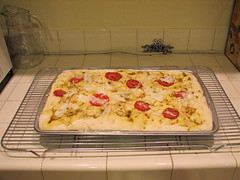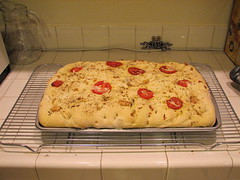
How fast are your garden snails?
Are they faster when you threaten them with garlic butter?
How do they leave dotted lines in their wake?
And what are you going to do with the built-in iSight camera on your new Mac?
Answer all of these questions at once with Gawker, a cute little GPL’d mac program that makes making time lapse movies a cinch.
Watch a 30-second quicktime clip of my garden here (1.7 MB quicktime .MOV). The video quality suffers a little from variable lighting [stupid moving clouds!] and the tiny lens.
Go snails go!
To make this movie, I put my computer outside, pointed the screen down at this little fellow, and hit “Record.” I believe that the frame rate setting was once every ten seconds.Suddenly, the idea of having little webcams seems like a good thing!
What next?
Well, here’s an interesting problem: I put my focaccia in the oven looking like this:
It comes out looking like this:
What happens in between? Well, I put my computer in front of the oven to watch.
The only light is from the oven light, which is unfortunately not very bright. I tried pointing a spotlight at the oven, but the glare on the oven door made it even harder to see inside. So, we’re stuck with a slightly dim movie, but fascinating anyway. Does anyone out there know how to make a lamp that works okay at 400 degrees?
Here’s the movie: Watch in the oven, one frame every 15 s, (160 kB quicktime .MOV).







Why not just use a regular video camera and then speed up the footage on your computer?
— Elliot
Storage, mainly. If you record for 4 hours and then compress it down to 30 seconds, you’ll still need enough hard drive space for the whole 4 hours. This way you only need the 30 seconds worth.
Reminds me of a paper from Journal of Experimental Marine Biology and Ecology just out last month – something about using time lapse digital photography to track behavior patterns in clams. "A Clockwork Mollusc" or something what like.
Can’t imagine why.
20 GB of photos of clams cluttering my hard drive. Something like a year’s worth of images taken every 20 seconds. It is possible to take this entirely too far, you realize.
Was this your paper by any chance? =)
—
Windell H. Oskay
drwho(at)evilmadscientist.com
http://www.evilmadscientist.com/
T’is possible. ;) I never did try to calibrate snail transit rates, but it would’ve been an easy enough task. On the other hand, freshwater bivalves are much more mobile than you might think.
take a normal lamp, use clear insulating, then put heat-resistent glass on it
or just use one from an old oven